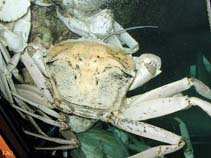Chaceon bicolor Manning & Holthuis, 1989
Pacific golden crabWarning: DOMDocument::load(): SSL operation failed with code 1. OpenSSL Error messages: error:140770FC:SSL routines:SSL23_GET_SERVER_HELLO:unknown protocol in C:\Apache24\htdocs\includes\SpeciesSummary.lib.php on line 1236
Warning: DOMDocument::load(): Failed to enable crypto in C:\Apache24\htdocs\includes\SpeciesSummary.lib.php on line 1236
Warning: DOMDocument::load(https://sealifebase.nrm.se/webservice/AquaMaps/getAMap.php?genus=Chaceon&species=bicolor): failed to open stream: operation failed in C:\Apache24\htdocs\includes\SpeciesSummary.lib.php on line 1236
Warning: DOMDocument::load(): I/O warning : failed to load external entity "https://sealifebase.nrm.se/webservice/AquaMaps/getAMap.php?genus=Chaceon&species=bicolor" in C:\Apache24\htdocs\includes\SpeciesSummary.lib.php on line 1236
Classification / Names Common names | Synonyms | CoL | ITIS | WoRMS
Malacostraca | Decapoda | Geryonidae
Environment: milieu / climate zone / depth range / distribution range Ecology
Benthic; depth range 200 - 1620 m (Ref. 343). Deep-water
Distribution Countries | FAO areas | Ecosystems | Occurrences | Introductions
Western Pacific.
Length at first maturity / Size / Weight / Age
Maturity: Lm ? range ? - ? cm Max length : 18.0 cm CW male/unsexed; (Ref. 343); 15 cm CW (female)
Short description Morphology
Carapace hexagonal; dorsal surface not inflated; anterolateral teeth low. Merus of legs long, slender. Dactylus of legs are laterally flattened, height at midlength greater than or subequal to width at midlength. Color: reddish tan to purplish black (anterior half of carapace may be differently colored than posterior half), sometimes cream-white throughout.
Maximum depth from Ref. 99823. Inhabits muddy substrates in deeper waters and sometimes burrows into the sediments (Ref. 343).
Life cycle and mating behavior Maturity | Reproduction | Spawning | Eggs | Fecundity | Larvae
Members of the order Decapoda are mostly gonochoric. Mating behavior: Precopulatory courtship ritual is common (through olfactory and tactile cues); usually indirect sperm transfer.
Main reference
References | Coordinator | Collaborators
Ng, P.K.L. 1998. (Ref. 343)
IUCN Red List Status (Ref. 130435)
CITES status (Ref. 108899)
Not Evaluated
CMS (Ref. 116361)
Not Evaluated
Threat to humans
Human uses
Fisheries: commercial
| FishSource |
Tools
More information
Internet sources
BHL | BOLD Systems | CISTI | DiscoverLife | FAO(Publication : search) | Fishipedia | GenBank (genome, nucleotide) | GloBI | Gomexsi | Google Books | Google Scholar | Google | PubMed | Tree of Life | Wikipedia (Go, Search) | Zoological Record
Estimates based on models
Preferred temperature
(Ref. 115969): 6.2 - 14.3, mean 8.9 (based on 31 cells).
Price category
(Ref. 80766):
Unknown.



